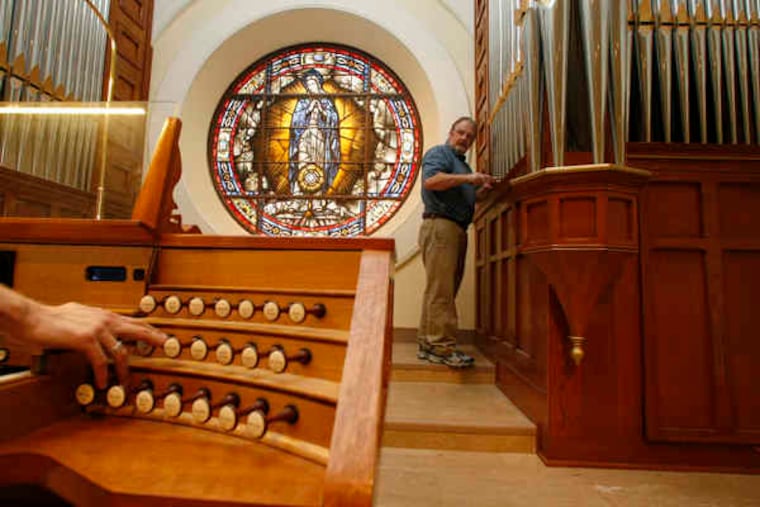Building a musical legacy
Four years ago, Colin Walsh was fixing the organ at Valley Forge Military Academy and College when he was struck by the name of the school's organist.

Four years ago, Colin Walsh was fixing the organ at Valley Forge Military Academy and College when he was struck by the name of the school's organist.
"I said, 'Dieffenbach as in the Dieffenbach?' " Walsh recalled.
As in the Berks County organ-building family whose works go back 200 years? Whose handiwork is in the National Music Museum in South Dakota?
"Yes," Adam Dieffenbach, then 23, replied.
Walsh offered him a job on the spot.
Now the two men are leading the team building a new organ for the chapel at the Cathedral Basilica of SS. Peter and Paul at 18th Street and the Parkway.
"The idea is to do something significant and long-lasting that reflects the importance of this building in Philadelphia in Catholicism," said Walsh, whose company, C.M. Walsh Pipe Organs, is based in Collingdale.
The Chapel of Our Lady of the Blessed Sacrament is the site of daily Masses and parishioner devotions, connected by a doorway to the Archdiocese of Philadelphia's mother church.
The chapel's new two-keyboard instrument, which is in the final tuning stages and is regularly being played, sits below a round window in the chapel loft, and its wood is stained a warm pecan color to match its surroundings. Flanking the window are about 800 carefully crafted pipes in zinc, tin, wood, and "spotted metal" tin-lead alloys.
For Walsh, the organ - with its potential for a seemingly endless combination of sounds - is unparalleled. It conveys the majestic, the meditative, and everything in between. The employees at C.M. Walsh Pipe Organs spend their days creating the intricate inner mechanics and gleaming exteriors that produce those sounds.
Walsh and his staff view their calling as one that preserves a craft whose peak has long passed.
Walsh, 47, of Aldan, began studying organ building while a 13-year-old apprentice in Dublin, Ireland, enamored with the way it combined music, technology, art, and woodworking.
After he moved to Philadelphia to join his brother, he met then-organ master Keith Chapman, who played at the John Wanamaker department store in Center City. Chapman helped Walsh get his first job. In 1995, Walsh started his company.
Dieffenbach, though an accomplished musician, had no experience in the trade before he met Walsh, despite his family history.
Dieffenbach's great-great-great-great-great-great-grandfather Johann Jacob Dieffenbach began building organs in Berks County in the late 1700s. Johann Jacob's son Christian, grandson David, and great-grandson Thomas followed in his footsteps.
Thomas died in 1900, and the family's involvement in organ building died with him - until Walsh ignited Dieffenbach's fire.
"I never felt I had to do this because it was my family history," Dieffenbach said, "but I had to do it because I don't want to do anything else."
Together, the men have spent two years on the $200,000 chapel project in a warehouse complex in Delaware County. Each room serves as the setting for a different stage of the organ's construction. There's a room with stacks of wood planks, with tools to carve the wood, with liquid to stain it, and with metal objects to assemble pipes and the inner workings.
Staffers Scott French, 32, and Steve Yutzy-Burkey, 34, have worked regularly on the project. Away from the warehouse, they are one-half of the Swimmers, a rock band with a growing reputation.
The musicians refer to the carving, cutting, and varnishing as a chance to participate in the creation of a traditional instrument.
An organist taps on a key that signals a valve to open, allowing wind to flow through a pipe and come out as an enveloping musical note.
The pipe organ "is not simulated sounds," said French, a drummer. "It's a living, breathing thing on its own."
When the chapel organ's pieces were finished, they were forklifted down from the second floor, and transported to Philadelphia to be assembled.
The cathedral project was complex because the chapel is used constantly and can never be without music. Walsh and company had to install a second organ in the loft so it could be played during their project.
The new organ is a smaller sibling of the four-keyboard instrument in the main cathedral. The organ builders made sure the two organs share some design elements, such as gold fluted pipe trim, to show that they are meant to be together.
"We're pursuing [a craft] that's almost gone - but it won't be as long as we're here," Walsh said.
Dieffenbach chimed in:
"As long as we're here - and passing it on."